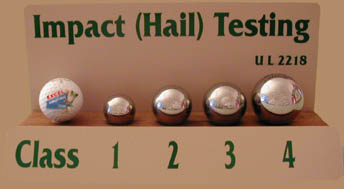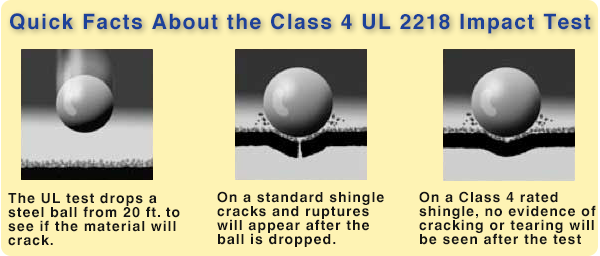Impact (Hail) Resistant Roofs
What Are Impact Resistant Roofs?
Destroyed windows on your brand-new car, damaged roof (again), sounds of what seems the sky falling down upon you outside… Know the feeling? If you are a resident in Colorado and the destruction of the infamous for this area hailstorm is something you are familiar with, keep reading this.
The good news for your roof is that even the problems caused by mother nature’s destructive forces have a solution.
Even though we work in the industry, it is never fun seeing our clients incur hail damage on their roofs and have been actively participating in new-age, hail-resistant roofing solutions, to make sure you stay safe and not having to worry about changing your roof for a long time, which we all know can be quite a heavy investment.
Enter the scene: Class 4 Hail Resistant Roofs.
Impact resistant roofs can withstand hail and windstorms. They require fewer repairs and last longer. Insurance companies like these roofs too! They liked the idea so much they decided to give discounts to consumers who installed them. However, the roof first needed a standardized test and rating system to determine the quality of the roofing materials used.
More info: Why Upgrade to Class 4 Singles in Colorado?
Who Tests Hail Resistant Roofs?
Underwriters Laboratories (UL) is a not-for-profit independent testing organization that was founded in 1894. UL provides the knowledge and expertise to help consumers make informed decisions on products that affect their daily lives. UL developed a test to rate the strength of roofing materials. This test is called the UL 2218 Impact Rating.
How Are Impact Resistant Roofs Classified?
The test uses steel balls ranging from 1.25 inches to 2.0 inches in diameter. The steel balls are dropped from heights of 12 feet for the 1.25 inch ball to 20 feet for the 2 inch ball. The test roof is struck twice in the same spot for each size steel ball.

To meet the acceptance criteria of UL 2218, the roofing material, back surface and underneath layers must show no evidence of tearing, fracturing, cracking, splitting, rupture, crazing or other evidence of opening of the roof covering layer.

After performing the test, roofing manufacturers would be scored based on the resistance of the material getting a rating from 1 least hail resistant to 4, most hail resistant.
Summarizing the result we would be looking at for, a Class 3 roof is earned if the sample does not crack when hit twice in the same spot by a 1.75 inch diameter steel ball. A Class 4 rating, the material should not get damaged when hit twice in the same spot by 2 inch diameter steel ball.
A Hail Resistant Roof Will Save You Money
In the last 10 years, hailstorms have caused more than $3 billion in property damage in Colorado and Wyoming, mainly to roofs. As a result, 30% of a home’s insurance cost is reserved for a new roof.
As a result of the huge losses, insurance companies are demanding more and more impact-resistant roofing materials on the market. To incentivize consumers, some insurers are offering discounts of up 25% on a homeowner’s insurance premium with impact resistant roofing.
Can Class 3 & 4 Roofs Ever Become Hail Damaged?
Hail resistant roofing offers the benefit of extra protection to your home. It is also important to understand that a hail resistant roof can still be damaged by large, wind-driven hail. The roof will be protected against an average hail storm so the chances of a damaged roof claim are much smaller, but there is still a chance for the roof to see hail damage during a bad storm.
Types of Hail Resistant Roofing Materials
Different manufacturers have different grades of hail resistant shingles, usually class 4 asphalt being the most common ones.
Limited Time Offer: Free Upgrade to Hail Resistant Roof
For a limited time, get a free upgrade to Owen Corning Duration Storm with your insurance claim roof replacement. This Offer is only valid in Colorado Springs.
Owens Corning Duration Storm Asphalt Shingles:
Owens Corning (OC) Duration Storm shingles are the most economical class 4 asphalt shingle on the market. They are more resistant to hail than normal shingles, however medium sized hail will damage them. This roof will qualify homeowners for a discount with most insurance companies. An OC Storm roof is about 5% more than a standard asphalt roof.
Owens Corning Duration Flex Shingles:
Owens Corning flex shingles are the best class 4 asphalt shingles on the market. These shingles are made from a rubberized asphalt and most hail literally bounces off of them, however large hail will damage these shingles. This roof will qualify homeowners for a discount with most insurance companies. An OC Duration Flex roof is about 10% more than a standard asphalt roof.
Concrete Tile:
The next classification of hail resistant products would be the concrete tiles, which range from weak to strong. These were also put to the test with ice balls from a cannon challenging the break strength and later on survived the real test of nature successfully in the hailstorm near The Broadmoor area in 2018.
Bartile Concrete Roofing
There are a number of very good concrete roofing manufacturers. We believe that Bartile is the best. Excel has installed over 1,000 tile roofs since 1993. Bartile has proven to be the strongest, and least susceptible to color changes. It takes very large hail to damage Bartile roofs, earning the Excel Roofing “Bombproof” rating. Concrete tile manufacturers use the Factory Mutual 4473 Ice ball cannon test to test tile. Some Insurance companies recognize this test and will give a discount for this roof. A Bartile roof costs about twice as much as a standard asphalt roof.
Synthetic Plastic Shingles
A third type of material is the synthetic, or plastic type category. Two brands of Synthetic roofs are DaVinci, and F-Wave.
These products are redefining the classifications and may merit a new “Class 5” at some point. These products are proving themselves to be indestructible.
F-Wave Synthetic Plastic Shingles:
F-Wave is a newer brand that mimics asphalt shingles. F-Wave is so confident in their roofing product that they offer a 5-year hail guarantee. If the roof is damaged by hail 2” in size or less in the first 5 years the F-Wave will replace the roof.
DaVinci Synthetic Plastic Shingles
Many DaVinci roofs survived unscathed in the Denver hailstorm of 2018. This was a storm with baseball size hail that caused hundreds of millions of dollars in damaged.
Stone coated steel
Stone Coated Steel roofing is made from steel panels that are formed into 4 foot sections and shaped to imitate cedar shakes and concrete tile. Stone coated steel has a class 4 rating, however the granules that are glued on the steel are susceptible to being knocked off by hail. Stone Coated Steel Panels are extremely lightweight and aa alternative to heavy concrete tile. The panels are easily dented if they are walked on by untrained personnel. This class for roof will qualify homeowners for a discount with most insurance companies. A stone coated steel roof costs about 2 1/2 times as much as a standard asphalt roof.
Roofing materials are changing for the better, becoming more and more advanced each year. And it doesn’t stop there.
At Excel Roofing you don’t pay a cent until you’re content!
To further help you get the best roof and protect your home, we offer 12-month 0% financing.
Stay risk free while testing out the strength, quality and endurance of our new age Class 4 Hail Resistant Roofs!
Be Mindful of T-LOCK Shingles
Back in 1930 when they were introduced, T-Lock shingles were the latest and greatest in roofing technology. They were easy to install and could withstand high winds and storms. The T-Lock shingle was ideal for Colorado’s always-changing and often-threatening weather. The heavier and thicker asphalt shingle found many home along the Front Range and across our state.
Not too much tech from the 30s is still in use today, including the T-Lock shingle. Their manufacture was halted in 2005. Even though they were rated to withstand winds up to 130 mph, their “wing” design actually acted like a sail and would rip off the roof during much slower wind speeds.
Also, as asphalt became more expensive, fillers were used instead. These fillers would become very brittle over time. Their woven design and installation doesn’t offer solid protection against hail either. The weaves can create pockets and gaps between shingles that can be easily damaged by hail.
T-Lock shingle lived long past its prime.
Many insurance companies won’t insure homes with a T-Lock roof. A new policy taken out on a home with T-Lock shingles will most likely require a roof replacement.
So if you are buying or selling a home with a T-Lock roof, it would be a good idea to call your insurance agent. If your T-Lock roof is damaged, it just simply can’t be repaired. No one makes them anymore. And your insurance company just may cover some of the costs to replace a T-Lock roof. They would prefer your home to have a newer roof that will better withstand the elements. Insurance companies just don’t like them, plain and simple.
They want to push the financial responsibility onto the homeowner. T-Lock roofs have depreciated value. They are tough to sell without being replaced. And it really is only a matter of time before they fail.
If you have a T-Lock roof and have any question, please contact Excel Roofing! We will be happy to assist you in any way we can and will even inspect your roof free of charge.





